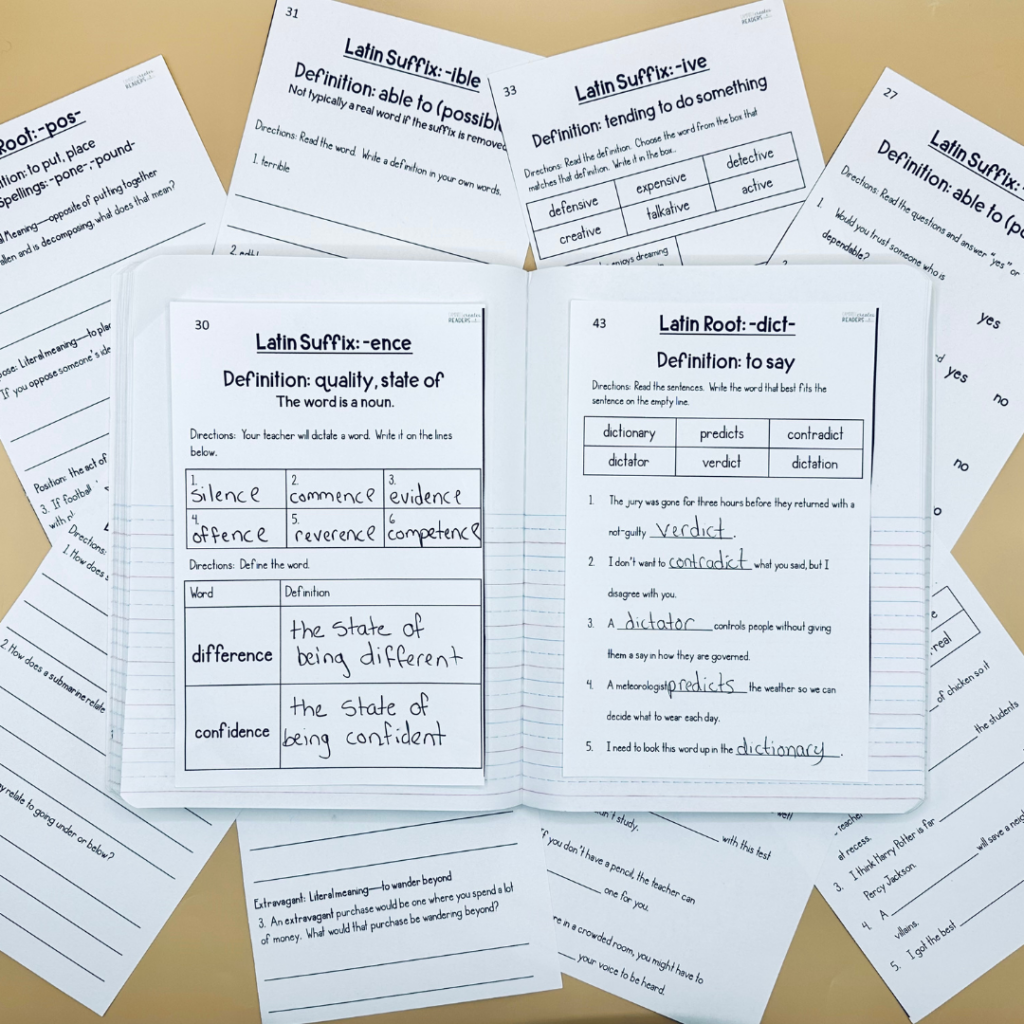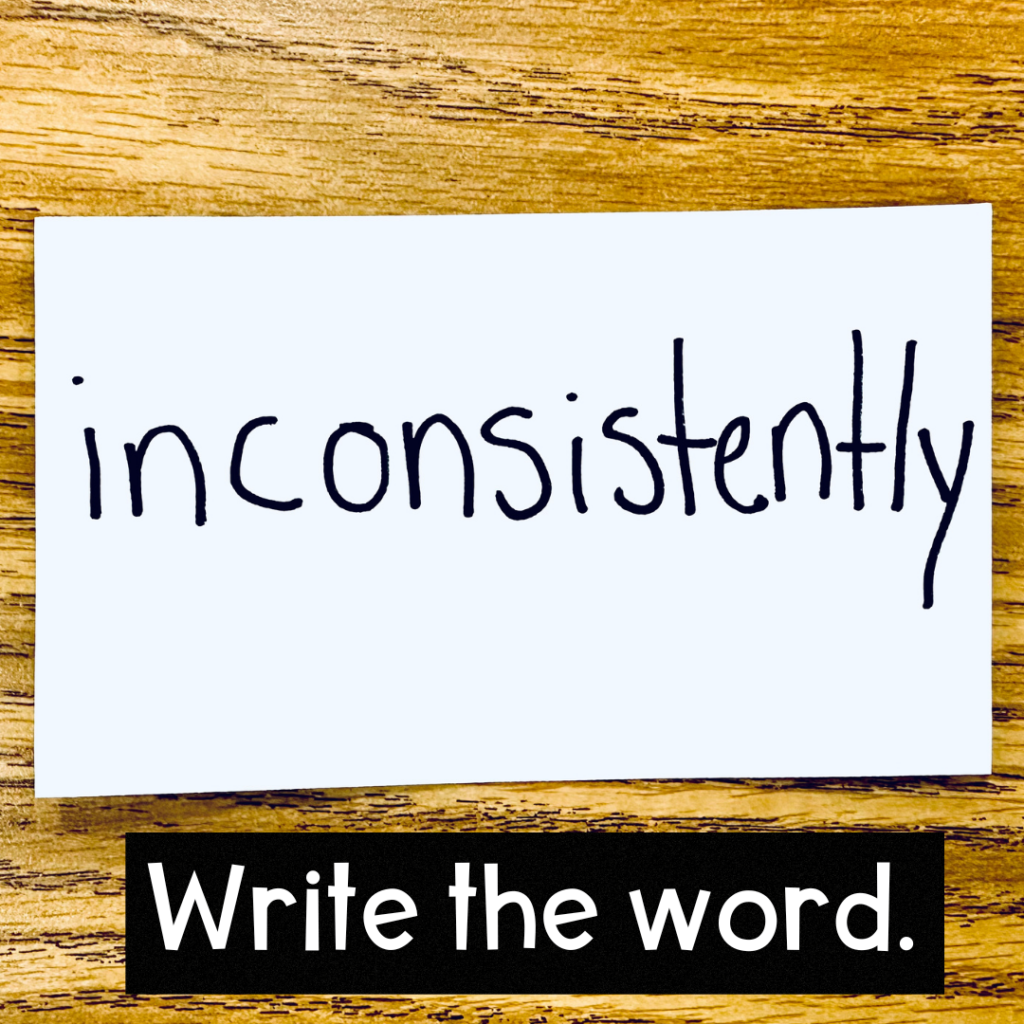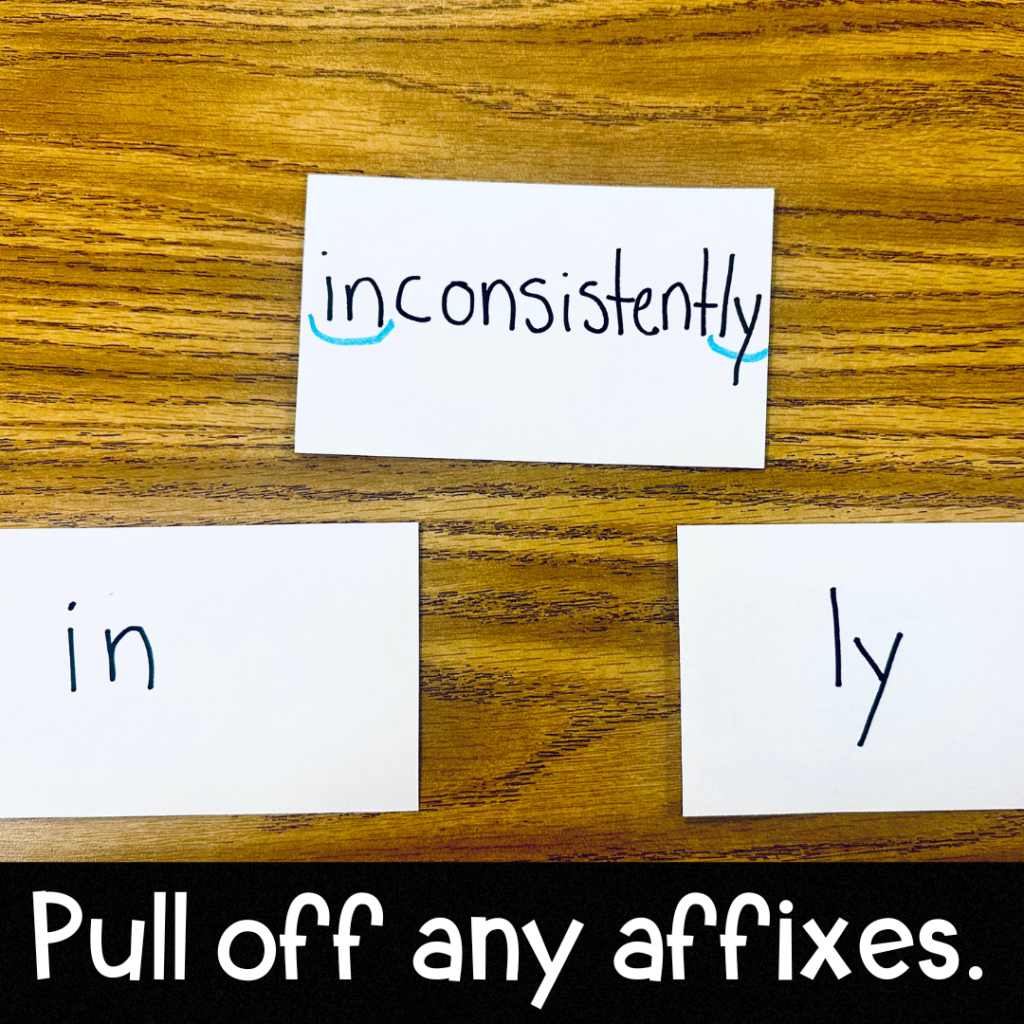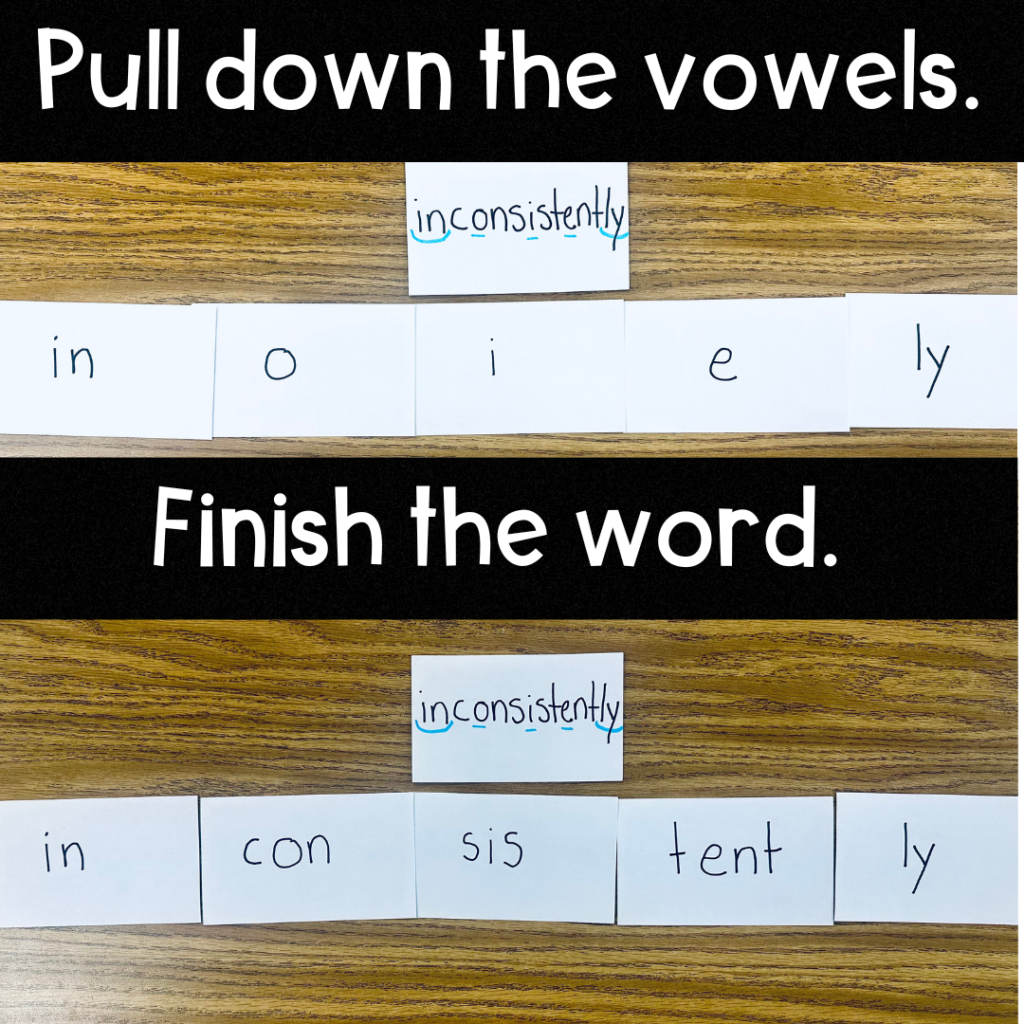
Share This:
Phonics in the early grades is important, but teaching single-syllable words is not sufficient—our kids must learn how to decode multisyllabic words. The great news? If we have done a good job of teaching those single-syllable words in the primary grades, then learning how to decode multisyllabic words will be MUCH easier. Today, I want to talk about some components of teaching multisyllabic words, and then delve into a concrete strategy you can use.
Before I get into my favorite strategy, we need to talk about the English language a little bit. English is a morphophonemic language. What this means is that our language is not purely phonetic—we must rely on two different levels of understanding to read and spell words. On one hand, we have the phonetic level—those sound-symbol correspondences that we teach in the primary grades. But we ALSO have deal with the meaning level—those word parts that carry meaning in a word. Let me give you an example.
When I first started my phonics journey, I taught children about the suffix -ed. I let them know that it could represent the /id/, /d/, or /t/ sounds. They got it. They could read words with the suffix -ed flawlessly. But they still wrote lookd, plantid, and stopt. Why? Because although they understood the sounds of the morpheme, they did not internalize the meaning. Now, I teach the 3 sounds of -ed, but I am always taking it back to the fact that it is past tense. If a child writes lookt, I will prompt with “How do we make a word past tense?” and they will then switch it to -ed. Word parts carry meaning, and we CANNOT overlook that component when teaching our students.
If you are not teaching morphology to your students, you must. Morphology instruction cannot be an optional part of learning to read. In kindergarten and first grade, you can support this by teaching common endings such a s indicating plurality, -ed to mark past tense, and -ing for the present participle marker. When you teach morphology, you are teaching that there are word parts that can alter the meaning of a word.
There are three layers of English that should be explicitly taught: Anglo-Saxon, Latin, and Greek. Anglo-Saxon is the easiest to learn (it is the most concrete), so I always start there. In fact, when you teach -s, -ing, and -ed you are already teaching Anglo-Saxon. Anglo-Saxon is the easiest for a few reasons. First, you typically add prefixes and suffixes to a base word that can stand on its own. It is much easier to understand hope-ful (Anglo-Saxon origin) than it is to understand sub-con-tract (Latin origin.)
Latin is the next layer to be taught and has a huge impact on our English language. As much as 55% of English is derived from Latin. Greek is the most difficult layer of English and is appropriate in upper elementary and middle school. French is a layer of English, but it does not really have specific affixes that we need to learn.
Not sure where to start? I made a set of interactive notepages (just like my phonics ones) that are based on Anglo-Saxon, Latin, and Greek affixes. Unlike my phonics notepages that focus on sound-symbol correspondences, these notepages encourage students to reflect on meaning. Greek notepages are coming out by the end of February 2023!

If you are feeling overwhelmed with teaching morphology, take it back to how you teach phonics. Start with the sound (the affix), then go to the word level, the sentence level, and then the passage level. Ensure you are dictating both isolated words and sentences. Try not to overthink it or overcomplicate your life! While there are lots of activities you can use, start simple. (Honestly, I stay simple.)
The second critical component for learning multisyllabic words is vocabulary instruction. Sometimes the meaning processor can be overlooked when we are talking about phonics instruction. Have you ever heard a child pronounce a word like a question, even if they read the word correctly? It is only when we anchor the sound-symbol correspondences to meaning that children will become more efficient orthographic mappers. The more we can incorporate vocabulary instruction, the more our children’s vocabulary will grow and the easier it will be for them to read new words.
When I was in journalism in high school, I’ll never forget a word I couldn’t pronounce. I’ve always been a great reader, and learning new words came naturally to me. In one of our meetings, someone had the word “gridiron” in their proposal. I remember trying to figure it out. I eventually settled on the pronunciation of “grid-ear-on.” Why didn’t I know how to pronounce gridiron? I had no context for the word. I wasn’t a football fan, I didn’t really go to football games, and it held no meaning to me. So you can be the best decoder in the world, but without understanding the words you are reading, you will struggle.
I don’t want to leave you in the world of theory and not give you a concrete way to teach multisyllabic words. So, let’s get into strategy.
The best tool you can use for explicit instruction of multisyllabic words is also one of the most affordable: 4X6 dry erase notecards*. I use these to help students break larger words up into syllables. The notecards also add a multi-sensory component to instruction that is typically pretty dry and abstract.
When decoding larger words, I want children to see that all longer words are made up of smaller parts they already know. To that end, we use the dry erase notecards to make overwhelming words more manageable. Each notecard represents one syllable or affix (I do not say one syllable always, because some morphemes are multisyllabic, like -able).
Here is how we practice decoding unknown multisyllabic words. This is easiest to do in small group, but can definitely be done in a whole-group setting as well. You will have some children who already know how to pronounce the words—I ask them not say the word out loud yet so that others can have a chance to figure it out.

1. Take off any prefixes or suffixes. Prefixes and suffixes each get their own notecard. underline what you have removed.

2.Underline the vowels. Notice—do you have r-controlled, vowel teams, magic e, or a single vowel? R-controlled, vowel teams, and magic e all stay together in a syllable! The number of vowels you have underlined determines the number of syllables left. (Magic e is one syllable, vowel teams are one syllable.)
3. Pull your vowels down onto the appropriate number of notecards.
4. Using what you know about syllables, figure out where the remaining consonants go.

5. Read the word one syllable at a time, then blend.
If you practice this strategy often, you will help your children become more proficient in reading multisyllabic words. It’s concrete, it’s multi-sensory, and it is effective.
If, like me, you were never taught how to teach children single-syllable words, it can be daunting thinking about how to teach children to read multi-syllabic words. When I think about how I taught for the first 8 years of my teaching, I don’t think I ever gave children ANY strategies for decoding multisyllabic words. Instead of trying to incorporate everything at once, start small. Can you start adding multisyllabic word instruction into your small groups? Can you begin explicitly teaching vocabulary with texts you are already reading?
**As an Amazon affiliate, I may earn a small commission for purchases made through my links. Your support helps fuel my content creation. Thank you for shopping and discovering amazing new resources with me. Also, I would never share anything that I don’t believe in with every part of me!
Share This:

Savannah Campbell is a K-5 reading specialist. She has taught her entire 12-year teaching career at the school she went to as a child. She holds two master’s degrees in education from the College of William and Mary. Savannah is both Orton-Gillingham and LETRS trained. Her greatest hope in life is to allow all children to live the life they want by helping them to become literate individuals.

Savannah Campbell is a K-5 reading specialist. She has taught her entire 12-year teaching career at the school she went to as a child. She holds two master’s degrees in education from the College of William and Mary. Savannah is both Orton-Gillingham and LETRS trained. Her greatest hope in life is to allow all children to live the life they want by helping them to become literate individuals.
Feeling overwhelmed with all the terminology out there? Want to know the key terms all teachers need to teach phonics? In this FREE Rules of English cheat sheet, you get a 5 page pdf that takes you through the most important terms for understanding English—you’ll learn about digraphs, blends, syllable types, syllable divisions, and move. Grab today and take the stress out of your phonics prep!
